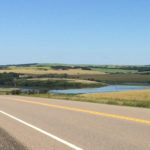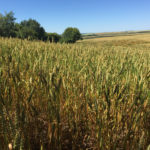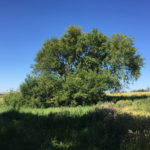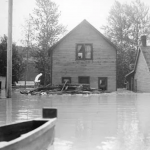
A sad ending to the homestead years!
My first visit to the homestead was in February of 2015 when the land was completely snowbound, leaving me with a strong desire to return in better weather. I came back in the summer of 2017 to see the land in its “full glory”. A year earlier, I had managed to contact the current owner and was intrigued by his description of a 100 year old maple (not indigenous to the area) near a well on one corner. Remembering the story of Grampa bringing a maple sapling to his parents in Heathfield during a return visit to England, this seemed to be more than a coincidence.
(click each photo to enlarge & see caption; use back arrow to return)
On that same trip, I visited the Historical Land Titles Office in Edmonton to try to determine how and when the homestead was sold. The documents revealed a sad story. The certificate of title dated January 1912, had a stamp on it indicating that it had been cancelled by foreclosure. Other pages showed several lenders who would probably have had to be paid before the final title was granted. These included:
- a court award of $134.83 (J.S.Lewis vs J.A. West) – March, 1912
- a mortgage of $900 (@8% per annum) – August, 1912
- A debt of $333.49 to the Albert Northern Lumber Company – October, 1912
- A debt of $620.05 to the Massey-Harris Co. – February, 1913 (interestingly, in that year, in Weyburn Saskatchewan, my paternal grandfather William Arthur More was a travelling farm equipment salesman for the Massey-Harris company)
- A sheriff’s order of foreclosure – October, 1913
- Foreclosure stamp – January, 1915
It is hard to imagine the stress that Grampa and Gramma must have been under during those months, losing the land on which they had worked so hard and indeed for which they had come to Canada. In May of 1915, Grampa signed up with the 49th battalion (Loyal Eddies), on June 14, his unit sailed to England, and on June 19th the Saskatchewan River overflowed its banks and Gramma with the 5 young children were forced out of their home in the Ross Flats area of Edmonton, along with 2400 others.
(click each photo to enlarge & see caption; use back arrow to return)
The sad history of homesteading in Saskatchewan and Alberta
The early years of the 20th century were a time of huge immigrations from Europe to Canada: Ethnic/Religious groups from continental Europe fleeing persecution (Mennonites, Doukhoubors) to groups simply seeking a better life (Ukrainians, British), all expected a Utopia, which for most never materialized. During these years, Canadian Pacific Railway promoters had promised “a fortune for everyone in three years, not to mention glittering promises of practically free land.” The reality was most often harsh winters, hot arid summers (especially in the Palliser Triangle, an agricultural area which included Grampa’s homestead). The immigrants who had the most success were those who had strong family connections (i.e. investment capital) or who homesteaded cooperatively (religious groups).
In actual fact, 40% of homesteads failed from 1871, and after the turn of the century less than half succeeded in completing their bid. Grampa’s family did succeed in completing all the requirements of the homestead process (required buildings erected, # of hectares of crops planted etc.), but in the end “the bank” won. In our happy, successful family of cousins, stories of the early century homestead were virtually non-existent. I now know why. See article:
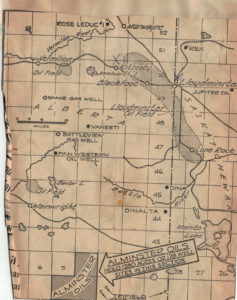
Other than the documentation, the only reference to those years which I have found in family documents is a mid-century newspaper article & map showing oil development areas of the Canadian prairies. Its presence in my mom’s scrapbook with no explanation of why it was there indicates that, at least in my mom’s generation, there was awareness and memory of the farm years, especially since it turns out that the old homestead was in the Lloydminster oil field. (see #49) Perhaps the presence of the article was a wistful “this nearly was ours?”
(click image to enlarge)
